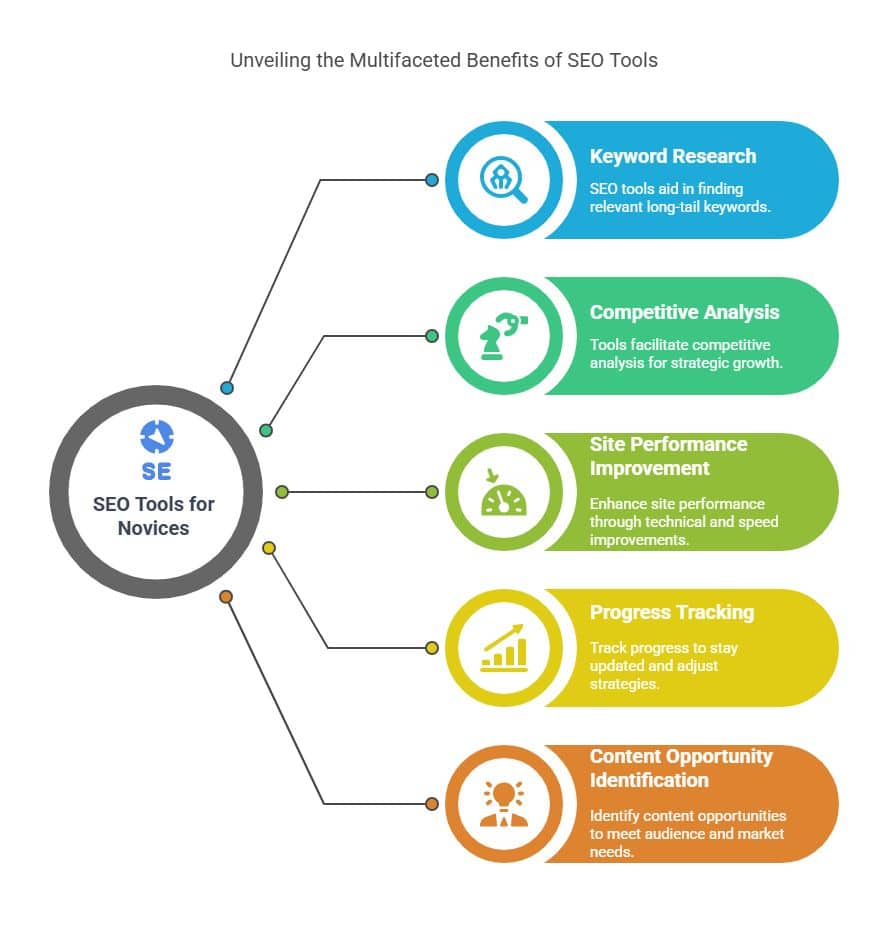
Why Should Newbies Use SEO Tools and Metrics?
Diving into digital marketing can feel like learning a new language, but don’t worry – we’ve all been there! SEO tools are like your trusted compass in this journey, helping you navigate the vast digital landscape. When you’re just starting out, keyword research is your first step – think of it as understanding what your audience is actually searching for, not just what you think they want. Competitor analysis isn’t about copying others – it’s more like being a smart observer, learning from both the wins and mistakes of those who’ve gone before you. Site performance tools are your website’s health checkers, pointing out what needs fixing before it becomes a bigger problem. Think of backlink profiles as your website’s reputation portfolio – it shows who’s vouching for your content. Whether you’re a small business owner or an aspiring marketer, this beginner’s guide to SEO tools and metrics is your roadmap to building a stronger online presence. Remember, everyone starts somewhere, and with these tools in your arsenal, you’re already ahead of the game!
Key Takeaways
- SEO tools make it easier to identify content opportunities and develop tactics that satisfy audience preferences and market demands.

Simplifying Keyword Research

When entering the realm of search engine optimization, keyword research stands as a pivotal element that can greatly influence the success of any digital endeavor. For newcomers to SEO, the process of identifying the right keywords can seem daunting. However, understanding and simplifying this process is crucial for achieving optimal results.
The strategic selection of long tail keywords, which are often more specific and less competitive, can significantly enhance content visibility and attract targeted audiences. These keywords, typically comprising three or more words, reveal search intent more clearly than generic terms, thus aligning content more closely with user queries.
Keyword difficulty is another critical factor to consider. It reflects the competition level for a particular keyword and helps in determining the feasibility of ranking for it. Newbies should opt for keywords with lower difficulty to increase their chances of success in search engine results.
Additionally, local SEO can be particularly beneficial for businesses targeting specific geographic areas. By incorporating location-specific keywords, organizations can improve their visibility within local search results, thereby catering to a more relevant audience.
Furthermore, remaining informed about keyword trends is essential. The digital landscape is constantly evolving, and staying abreast of the latest trends ensures that content remains relevant and competitive. SEO tools can assist in tracking these trends, providing valuable insights into the shifting patterns of user behavior.
Understanding Competitor Analysis

Understanding competitor analysis is a fundamental aspect of SEO that enables businesses to gauge their standing within the digital marketplace. By engaging in competitor analysis, companies can perform competitor benchmarking, which involves comparing their SEO performance against others in the industry. This process provides invaluable insights into market positioning, helping businesses understand where they stand relative to competitors and identifying potential areas for improvement.
Competitor analysis also reveals content gaps, which are opportunities where competitors may be underperforming or where demand is unmet. By identifying these gaps, businesses can tailor their content strategies to address these areas, thereby gaining a competitive edge.
Furthermore, understanding audience insights gleaned from competitor analysis allows companies to refine their messaging and better align it with the preferences and behaviors of their target audience.
An essential component of effective competitor analysis is strategy formulation. By analyzing competitors’ SEO tactics, businesses can develop informed strategies that leverage competitors’ strengths and weaknesses. This not only aids in adopting best practices but also in avoiding common pitfalls experienced by competitors.
It empowers businesses to craft a more comprehensive and robust SEO strategy that is both proactive and reactive to market changes.
In essence, competitor analysis is a strategic tool that offers a wealth of information for businesses aiming to enhance their digital visibility. By systematically evaluating the competitive landscape, companies can make data-driven decisions that foster growth and ensure sustained success in the ever-evolving digital arena.
For SEO newcomers, mastering this analysis is crucial for carving out a unique space in the competitive digital marketplace.
Enhancing Site Performance

Building on the insights gained from competitor analysis, enhancing site performance becomes a critical next step in optimizing SEO efforts. For beginners, understanding the multifaceted elements that contribute to site performance is essential. One key aspect is site speed, which can significantly affect user engagement and conversion rates.
Search engines prioritize fast-loading websites, making it vital to utilize SEO tools that help identify and rectify speed bottlenecks. Tools like Google PageSpeed Insights offer detailed reports and actionable recommendations to improve load times, thereby enhancing user experience and search rankings.
Mobile optimization is another crucial factor, as a substantial portion of web traffic originates from mobile devices. Ensuring that a website is fully responsive and provides a seamless experience across all devices is imperative. Mobile-friendly design not only enhances user engagement but also aligns with search engine algorithms that favor mobile-optimized sites.
Conducting regular technical audits is indispensable for maintaining and improving site performance. These audits help detect issues such as broken links, duplicate content, and missing metadata, which can negatively impact rankings.
SEO tools like Screaming Frog and SEMrush can automate these audits, providing insights into areas requiring improvement.
Content quality remains a cornerstone of effective SEO strategies. High-quality, relevant content attracts and retains users, encouraging longer site visits and reducing bounce rates.
It is essential to regularly update content to keep it fresh and aligned with user intent. By leveraging SEO tools to analyze content performance, newbies can fine-tune their strategies to better meet audience needs, ultimately fostering improved site performance and visibility.
Tracking SEO Progress
Monitoring SEO progress is an essential practice for evaluating the effectiveness of optimization efforts. By staying informed about current SEO trends and understanding how tracking algorithms work, businesses can adapt and refine strategies to enhance online visibility. Setting benchmarks allows organizations to measure progress objectively and make informed decisions about future tactics. In this context, the use of reporting tools and data visualization becomes indispensable.
Effective tracking of SEO progress involves multiple facets:
- SEO Trends: Keeping up with the latest developments in SEO ensures that strategies remain relevant. Trends may influence how search engines rank content, necessitating adjustments in approach.
- Tracking Algorithms: Understanding the algorithms that drive search engine results is crucial. These algorithms determine the visibility of content, and staying informed helps in anticipating changes that could affect performance.
- Setting Benchmarks: Establishing clear benchmarks provides a reference point for measuring success. Benchmarks should be realistic and based on historical data to effectively gauge improvement over time.
Reporting tools are invaluable for compiling data into comprehensive reports, offering insights into which strategies are working and which need refinement. They often include features for data visualization, presenting complex information in an accessible format. This enables stakeholders to quickly grasp trends and make data-driven decisions.
Ultimately, tracking SEO progress is not just about reacting to data but proactively using it to guide strategic decisions. By leveraging information on SEO trends, understanding tracking algorithms, and setting meaningful benchmarks, businesses can maintain a competitive edge in the digital landscape.
Embracing these practices will empower them to optimize their online presence effectively.
Identifying Content Opportunities

Unearthing content opportunities is a critical component of any successful SEO strategy. By leveraging SEO tools and metrics, newbies can efficiently identify content gaps, ultimately enhancing their online presence. Understanding what is missing in the existing market landscape allows content creators to fill these voids with valuable and engaging material, which not only attracts new audiences but also retains existing ones.
SEO tools are indispensable in recognizing content trends and shifts in user preferences. By analyzing search data and tracking keyword performance, these tools offer crucial audience insights, enabling creators to tailor content to meet the evolving demands of their target demographic. This data-driven approach ensures that content remains relevant and competitive in a constantly changing digital environment.
Exploring various content formats is another significant aspect of identifying new opportunities. Whether it’s a blog post, video, infographic, or podcast, different formats resonate with diverse audience segments. Tools that track engagement metrics help creators determine which formats yield the highest impact, guiding them in optimizing their content strategy to suit their audience’s preferences.
Focusing on niche topics is equally essential in distinguishing one’s content from the vast sea of information available online. SEO tools enable users to discover underserved or emerging topics within their industry, allowing them to capitalize on these areas before they become saturated.
Improving User Experience

Consistently enhancing user experience is fundamental to successful SEO, as it directly influences how visitors interact with a website. When users find a website easy to navigate and its content easy to read, they are more likely to engage, resulting in improved engagement metrics.
Understanding user behavior through SEO tools allows webmasters to make informed decisions on optimizing user experience. These tools provide insights into how users interact with different elements of a site such as site navigation and content readability.
A significant aspect of modern SEO is mobile usability. As more users access websites through mobile devices, ensuring that a website is mobile-friendly is crucial. SEO tools can assess a site’s mobile usability, offering suggestions for improving load times and layout, which are vital for retaining mobile visitors.
By enhancing mobile experiences, websites can reduce bounce rates and increase user engagement.
Improving user experience also involves simplifying site navigation. A well-structured site allows users to find information quickly, enhancing their overall experience. SEO tools can analyze navigation paths and highlight areas of complexity or potential confusion, enabling webmasters to streamline the user journey.
- Content Readability: Ensures content is easily digestible, catering to a wider audience and encouraging longer site visits.
- User Behavior: Understanding how users interact with the website helps in tailoring content and design to meet their needs.
- Engagement Metrics: Metrics such as time on page and bounce rate provide insights into user satisfaction and areas for improvement.
Monitoring Backlink Profiles
A robust user experience is complemented by a strong backlink profile, which plays a pivotal role in a website’s search engine ranking. Monitoring backlink profiles is essential for understanding how your site is perceived across the web. For newcomers to SEO, this might seem daunting, but employing SEO tools for backlink audits can illuminate the complexities of link building, which is a cornerstone of enhancing domain authority.
Backlink audits are crucial in identifying both beneficial and toxic backlinks. Beneficial backlinks are those that enhance your site’s credibility and visibility, while toxic backlinks can harm your search engine ranking due to association with spammy or low-quality sites. Regularly auditing your backlinks helps maintain a clean profile, ensuring that only quality links contribute to your domain authority. SEO tools can streamline this process, allowing users to easily identify and disavow harmful links.
The role of anchor text in backlinks should not be underestimated. Anchor text serves as a relevancy signal to search engines, indicating what a linked page is about. Strategic use of varied and relevant anchor texts can enhance the effectiveness of your link building efforts. SEO tools provide insights into anchor text distribution, helping ensure a natural and diverse profile that avoids over-optimization penalties.
Ultimately, the insights gained from monitoring backlink profiles empower website owners to make informed decisions about their link building strategies. By understanding the nuances of backlinks, domain authority, and anchor text, even those new to SEO can effectively enhance their site’s performance and achieve sustainable growth in search engine rankings.
Analyzing Traffic Sources

Understanding where your website’s visitors originate is a fundamental aspect of building a successful online presence. Analyzing traffic sources enables website owners to gain insights into traffic behavior, facilitating informed decisions that propel growth.
By interpreting data regarding audience demographics and engagement metrics, businesses can tailor their strategies to better meet the needs of their audience.
Traffic source comparison is crucial in identifying which channels are most effective in driving visitors to your site. This process involves evaluating sources such as organic search, direct visits, social media referrals, and paid advertisements.
Recognizing the strengths and weaknesses of each source allows for a more strategic allocation of resources.
Referral analysis plays a pivotal role in understanding the pathways through which users find your website. By examining which external sites or platforms are sending traffic, businesses can identify potential partnerships or opportunities to expand their reach.
Knowing which referrals generate the most engagement helps prioritize efforts towards maintaining those high-performing relationships.
Engagement metrics further refine the analysis by illustrating how visitors interact with the site once they arrive. Metrics such as bounce rate, average session duration, and pages per session offer valuable insights into the quality of traffic each source provides.
Armed with this information, businesses can optimize their strategies to enhance user experience and increase conversion rates.
- Traffic Behavior: Understanding how visitors navigate and interact with your site helps tailor content to meet their needs.
- Source Comparison: Identifies which channels most effectively drive traffic, allowing for strategic resource allocation.
- Audience Demographics: Helps in crafting content and strategies that resonate with your target audience.
Optimizing On-Page Elements

Enhancing the on-page elements of a website is pivotal for improving its visibility and performance in search engine results. On-page optimization involves refining various components of a webpage to align with search engine algorithms and user expectations. For newcomers, understanding and utilizing these elements can significantly boost a site’s search engine ranking.
Meta tags, including the title and description, are essential as they provide search engines with a brief overview of the page’s content. Crafting concise and relevant meta tags ensures that search engines can accurately index the page, improving click-through rates from search results.
The header structure of a webpage acts as an organizational framework, guiding both users and search engines through the content. Utilizing header tags (H1, H2, H3, etc.) hierarchically not only enhances readability but also signals the importance of various sections to search engines.
Image optimization is another critical component. By compressing images and using descriptive, keyword-rich alt text, websites can improve loading times and accessibility, which are favored by search engines.
Internal linking plays a crucial role in on-page SEO by creating a logical flow of information and distributing page authority throughout the site. Thoughtful internal links can enhance user experience and help search engines understand the site’s structure and hierarchy.
Lastly, ensuring mobile responsiveness is vital as more users access websites via mobile devices. A mobile-responsive design ensures that a website functions seamlessly across different devices, which can positively impact user engagement and search engine rankings.
Incorporating these on-page elements effectively can significantly elevate a website’s performance and user engagement, laying a solid foundation for successful SEO practices.
Measuring ROI Effectively

After successfully optimizing on-page elements, it’s important to assess the effectiveness of these efforts by measuring the return on investment (ROI). By doing so, newbies can determine whether the resources devoted to SEO are yielding profitable returns. This process involves a meticulous cost analysis, where all expenditures, including time and tools, are accounted for.
Once costs are established, the next step is metric interpretation. This involves analyzing key performance indicators (KPIs) such as increased website traffic, higher conversion rates, and improved search engine rankings.
Selecting the right tools is crucial for accurate analysis and interpretation. Tools that offer comprehensive data visualization capabilities can provide clear insights into your SEO performance. Data visualization helps in understanding complex data patterns and trends, making it easier to communicate results and make informed decisions.
It’s also essential to engage in performance benchmarking, comparing your metrics against industry standards or competitors to gauge effectiveness.
To measure ROI effectively, consider the following:
- Tool Selection: Choose tools that align with your specific goals and provide robust data analysis and visualization features.
- Cost Analysis: Accurately account for all costs associated with your SEO efforts, including time, tools, and other resources.
- Metric Interpretation: Focus on interpreting KPIs that are directly tied to your objectives, such as traffic growth and conversion improvements.
Measuring ROI is not merely about numbers; it’s about understanding the impact of your SEO strategies on the overall business growth. By integrating cost analysis, tool selection, and performance benchmarking, newbies can effectively determine the true value of their SEO investments.
Final Thoughts
Mastering SEO tools and metrics is an invaluable investment for anyone stepping into the digital marketing landscape. While the journey may seem complex at first, understanding these fundamental elements – from keyword research and competitor analysis to site performance optimization and ROI measurement – creates a solid foundation for long-term success. By approaching these tools systematically and staying committed to continuous learning, newcomers can transform what might initially appear as overwhelming data into actionable insights that drive meaningful results in their digital marketing endeavors.
If you’re looking to navigate the world of SEO tools and metrics with confidence, Syville Gacutan, an experienced SEO Specialist in the Philippines, is here to help. With a deep understanding of SEO fundamentals and a proven track record of delivering results, Syville can guide you through the process, turning complex data into clear, actionable strategies for your digital success. Don’t miss the opportunity to accelerate your SEO journey – connect with Syville today.